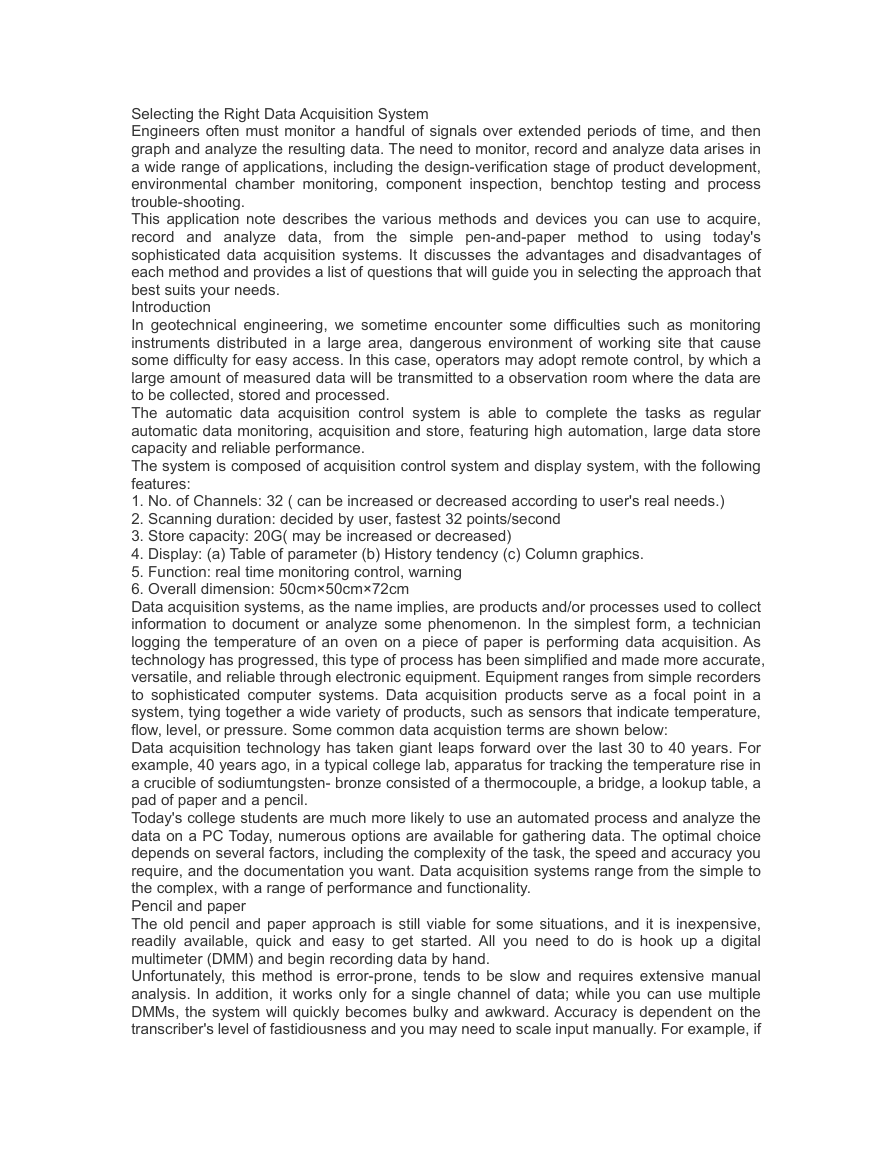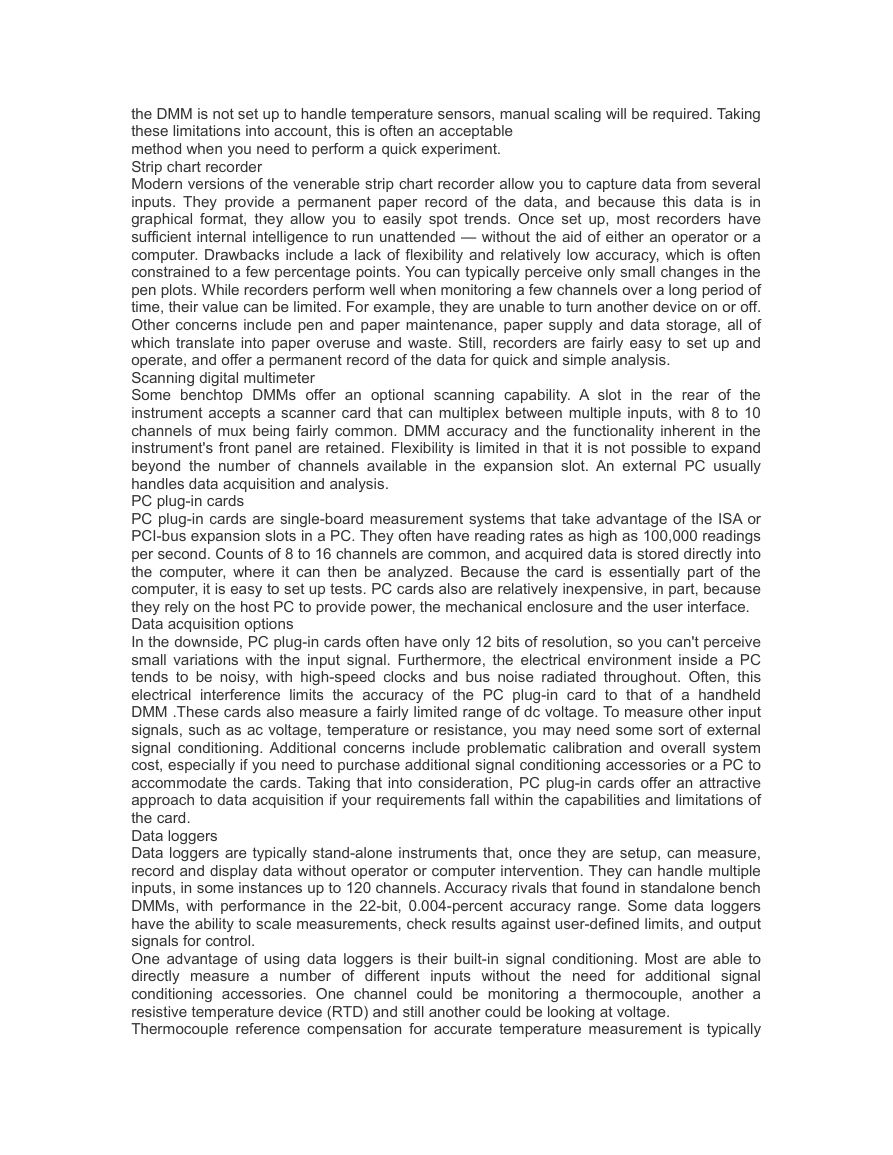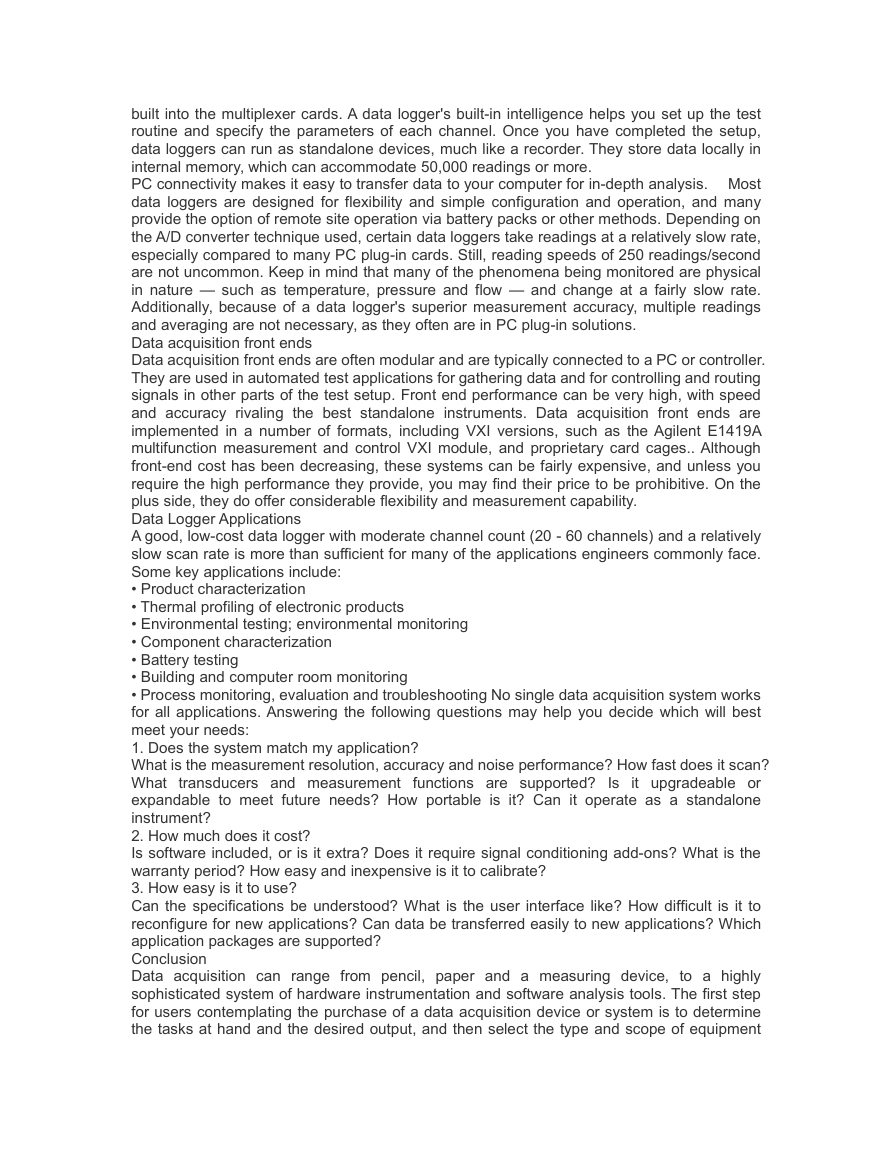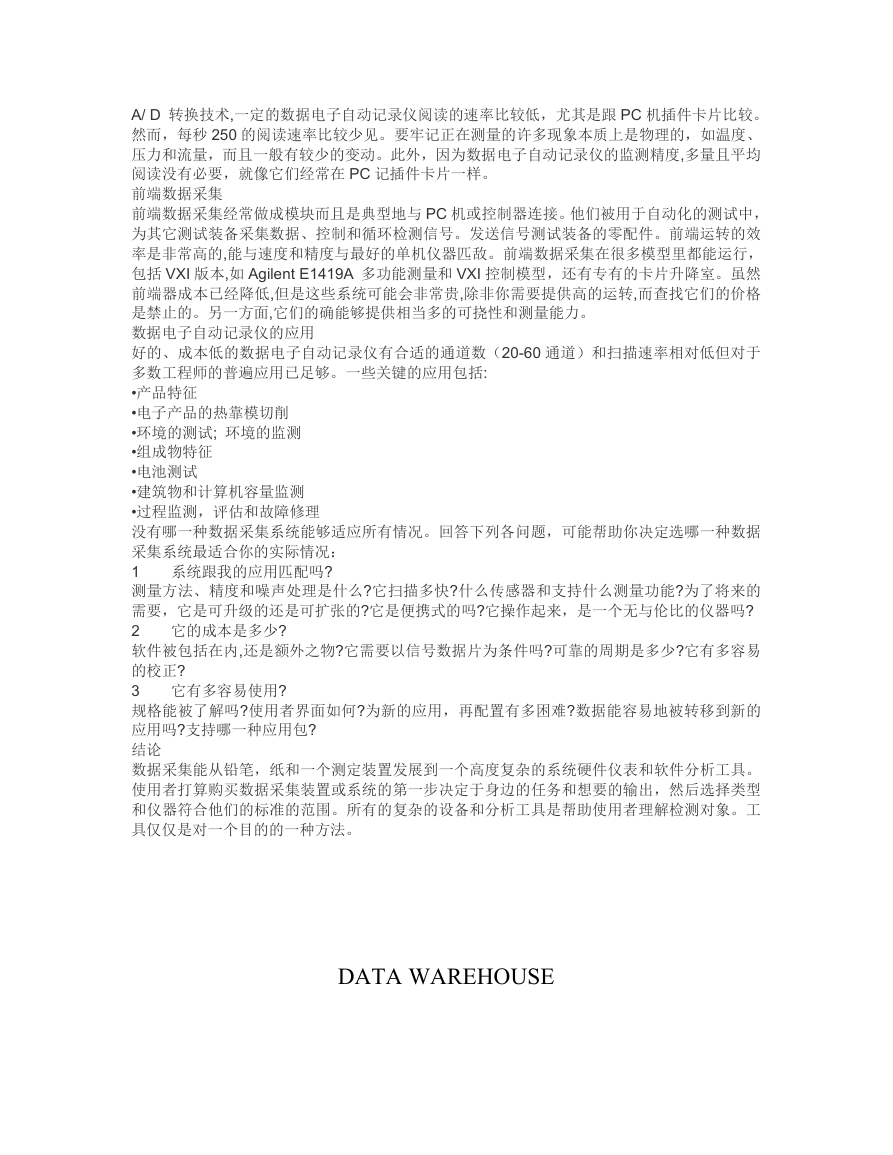Selecting the Right Data Acquisition System
Engineers often must monitor a handful of signals over extended periods of time, and then
graph and analyze the resulting data. The need to monitor, record and analyze data arises in
a wide range of applications, including the design-verification stage of product development,
environmental chamber monitoring, component inspection, benchtop testing and process
trouble-shooting.
This application note describes the various methods and devices you can use to acquire,
record and analyze data,
from the simple pen-and-paper method to using today's
sophisticated data acquisition systems. It discusses the advantages and disadvantages of
each method and provides a list of questions that will guide you in selecting the approach that
best suits your needs.
Introduction
In geotechnical engineering, we sometime encounter some difficulties such as monitoring
instruments distributed in a large area, dangerous environment of working site that cause
some difficulty for easy access. In this case, operators may adopt remote control, by which a
large amount of measured data will be transmitted to a observation room where the data are
to be collected, stored and processed.
The automatic data acquisition control system is able to complete the tasks as regular
automatic data monitoring, acquisition and store, featuring high automation, large data store
capacity and reliable performance.
The system is composed of acquisition control system and display system, with the following
features:
1. No. of Channels: 32 ( can be increased or decreased according to user's real needs.)
2. Scanning duration: decided by user, fastest 32 points/second
3. Store capacity: 20G( may be increased or decreased)
4. Display: (a) Table of parameter (b) History tendency (c) Column graphics.
5. Function: real time monitoring control, warning
6. Overall dimension: 50cm×50cm×72cm
Data acquisition systems, as the name implies, are products and/or processes used to collect
information to document or analyze some phenomenon. In the simplest form, a technician
logging the temperature of an oven on a piece of paper is performing data acquisition. As
technology has progressed, this type of process has been simplified and made more accurate,
versatile, and reliable through electronic equipment. Equipment ranges from simple recorders
to sophisticated computer systems. Data acquisition products serve as a focal point in a
system, tying together a wide variety of products, such as sensors that indicate temperature,
flow, level, or pressure. Some common data acquistion terms are shown below:
Data acquisition technology has taken giant leaps forward over the last 30 to 40 years. For
example, 40 years ago, in a typical college lab, apparatus for tracking the temperature rise in
a crucible of sodiumtungsten- bronze consisted of a thermocouple, a bridge, a lookup table, a
pad of paper and a pencil.
Today's college students are much more likely to use an automated process and analyze the
data on a PC Today, numerous options are available for gathering data. The optimal choice
depends on several factors, including the complexity of the task, the speed and accuracy you
require, and the documentation you want. Data acquisition systems range from the simple to
the complex, with a range of performance and functionality.
Pencil and paper
The old pencil and paper approach is still viable for some situations, and it is inexpensive,
readily available, quick and easy to get started. All you need to do is hook up a digital
multimeter (DMM) and begin recording data by hand.
Unfortunately, this method is error-prone, tends to be slow and requires extensive manual
analysis. In addition, it works only for a single channel of data; while you can use multiple
DMMs, the system will quickly becomes bulky and awkward. Accuracy is dependent on the
transcriber's level of fastidiousness and you may need to scale input manually. For example, if
�
the DMM is not set up to handle temperature sensors, manual scaling will be required. Taking
these limitations into account, this is often an acceptable
method when you need to perform a quick experiment.
Strip chart recorder
Modern versions of the venerable strip chart recorder allow you to capture data from several
inputs. They provide a permanent paper record of the data, and because this data is in
graphical format, they allow you to easily spot trends. Once set up, most recorders have
sufficient internal intelligence to run unattended — without the aid of either an operator or a
computer. Drawbacks include a lack of flexibility and relatively low accuracy, which is often
constrained to a few percentage points. You can typically perceive only small changes in the
pen plots. While recorders perform well when monitoring a few channels over a long period of
time, their value can be limited. For example, they are unable to turn another device on or off.
Other concerns include pen and paper maintenance, paper supply and data storage, all of
which translate into paper overuse and waste. Still, recorders are fairly easy to set up and
operate, and offer a permanent record of the data for quick and simple analysis.
Scanning digital multimeter
Some benchtop DMMs offer an optional scanning capability. A slot
the
instrument accepts a scanner card that can multiplex between multiple inputs, with 8 to 10
channels of mux being fairly common. DMM accuracy and the functionality inherent in the
instrument's front panel are retained. Flexibility is limited in that it is not possible to expand
beyond the number of channels available in the expansion slot. An external PC usually
handles data acquisition and analysis.
PC plug-in cards
PC plug-in cards are single-board measurement systems that take advantage of the ISA or
PCI-bus expansion slots in a PC. They often have reading rates as high as 100,000 readings
per second. Counts of 8 to 16 channels are common, and acquired data is stored directly into
the computer, where it can then be analyzed. Because the card is essentially part of the
computer, it is easy to set up tests. PC cards also are relatively inexpensive, in part, because
they rely on the host PC to provide power, the mechanical enclosure and the user interface.
Data acquisition options
In the downside, PC plug-in cards often have only 12 bits of resolution, so you can't perceive
small variations with the input signal. Furthermore, the electrical environment inside a PC
tends to be noisy, with high-speed clocks and bus noise radiated throughout. Often, this
electrical
the PC plug-in card to that of a handheld
DMM .These cards also measure a fairly limited range of dc voltage. To measure other input
signals, such as ac voltage, temperature or resistance, you may need some sort of external
signal conditioning. Additional concerns include problematic calibration and overall system
cost, especially if you need to purchase additional signal conditioning accessories or a PC to
accommodate the cards. Taking that into consideration, PC plug-in cards offer an attractive
approach to data acquisition if your requirements fall within the capabilities and limitations of
the card.
Data loggers
Data loggers are typically stand-alone instruments that, once they are setup, can measure,
record and display data without operator or computer intervention. They can handle multiple
inputs, in some instances up to 120 channels. Accuracy rivals that found in standalone bench
DMMs, with performance in the 22-bit, 0.004-percent accuracy range. Some data loggers
have the ability to scale measurements, check results against user-defined limits, and output
signals for control.
One advantage of using data loggers is their built-in signal conditioning. Most are able to
directly measure a number of different
the need for additional signal
conditioning accessories. One channel could be monitoring a thermocouple, another a
resistive temperature device (RTD) and still another could be looking at voltage.
Thermocouple reference compensation for accurate temperature measurement is typically
interference limits the accuracy of
in the rear of
inputs without
�
built into the multiplexer cards. A data logger's built-in intelligence helps you set up the test
routine and specify the parameters of each channel. Once you have completed the setup,
data loggers can run as standalone devices, much like a recorder. They store data locally in
internal memory, which can accommodate 50,000 readings or more.
PC connectivity makes it easy to transfer data to your computer for in-depth analysis. Most
data loggers are designed for flexibility and simple configuration and operation, and many
provide the option of remote site operation via battery packs or other methods. Depending on
the A/D converter technique used, certain data loggers take readings at a relatively slow rate,
especially compared to many PC plug-in cards. Still, reading speeds of 250 readings/second
are not uncommon. Keep in mind that many of the phenomena being monitored are physical
in nature — such as temperature, pressure and flow — and change at a fairly slow rate.
Additionally, because of a data logger's superior measurement accuracy, multiple readings
and averaging are not necessary, as they often are in PC plug-in solutions.
Data acquisition front ends
Data acquisition front ends are often modular and are typically connected to a PC or controller.
They are used in automated test applications for gathering data and for controlling and routing
signals in other parts of the test setup. Front end performance can be very high, with speed
and accuracy rivaling the best standalone instruments. Data acquisition front ends are
implemented in a number of formats, including VXI versions, such as the Agilent E1419A
multifunction measurement and control VXI module, and proprietary card cages.. Although
front-end cost has been decreasing, these systems can be fairly expensive, and unless you
require the high performance they provide, you may find their price to be prohibitive. On the
plus side, they do offer considerable flexibility and measurement capability.
Data Logger Applications
A good, low-cost data logger with moderate channel count (20 - 60 channels) and a relatively
slow scan rate is more than sufficient for many of the applications engineers commonly face.
Some key applications include:
• Product characterization
• Thermal profiling of electronic products
• Environmental testing; environmental monitoring
• Component characterization
• Battery testing
• Building and computer room monitoring
• Process monitoring, evaluation and troubleshooting No single data acquisition system works
for all applications. Answering the following questions may help you decide which will best
meet your needs:
1. Does the system match my application?
What is the measurement resolution, accuracy and noise performance? How fast does it scan?
What
functions are supported? Is it upgradeable or
expandable to meet future needs? How portable is it? Can it operate as a standalone
instrument?
2. How much does it cost?
Is software included, or is it extra? Does it require signal conditioning add-ons? What is the
warranty period? How easy and inexpensive is it to calibrate?
3. How easy is it to use?
Can the specifications be understood? What is the user interface like? How difficult is it to
reconfigure for new applications? Can data be transferred easily to new applications? Which
application packages are supported?
Conclusion
Data acquisition can range from pencil, paper and a measuring device,
to a highly
sophisticated system of hardware instrumentation and software analysis tools. The first step
for users contemplating the purchase of a data acquisition device or system is to determine
the tasks at hand and the desired output, and then select the type and scope of equipment
transducers and measurement
�
that meets their criteria. All of
the sophisticated equipment and analysis tools that are
available are designed to help users understand the phenomena they are monitoring. The
tools are merely a means to an end.
正确选择数据采集系统
工程师经常要对很长时间内的很多信号进行监测、画图和分析产生的数据。监测、记录和分析
数据在大范围内的应用趋势上升,包括设计-检定产品发展状态、环境的监测、组成物的检验、
benchtop 测试和处理故障检查。
从简单的纸笔记录方法到现在所使用的复杂的数据采集系统这些应用笔记描述了你能获得、记
录和分析数据的很多种不同方法和装置。讨论每一种方法的缺点和优点,然后列出一张能够指
引你选择适合你实际需要的问题单。
前言
在工程上,我们有时遇到一些困难,诸如监控设备分散在大范围内,危险的工作环境很容易引
发一些困难。在这种情况下,操作者可能采用视讯遥控,通过大量检测数据传输到检测室,在
那里收集、存储和处理数据。
自动数据采集的控制系统能够完成很多任务,像自动定时数据监测,数据采集和存储,高度自
动化为特色,大量数据存储能力和可靠功能。
自动数据采集的控制系统和显示系统优如下特点:
1 多通路数:32(根据使用者的需要增长或减少)
2 扫描持续时间:由使用者决定,最快一秒种扫描 32 点
3 存储容量:20G(可能增加或减少)
4 显示:(a)参数表 (b)历史趋势 (c)专栏图表
5 功能:实时监测、控制和报警
6 大体尺寸:50cm×50cm×72cm
数据采集系统,正如名字所暗示的,是一种用来采集信息成文件或分析一些现象的产品或过程。
在最简单的形式中,技术人员将烤箱的温度记录在一张纸上就是数据采集。随着技术的发展,
通过电子设备,这个过程已经得到简化和变得比较精确、多用途和可靠。设备从简单的存储器
发展到复杂的电脑系统。数据采集产品像聚焦点一样为系统服务,和一系列产品一起,诸如传
感器显示温度、水流、程度或者过程。
数据采集技术在过去 30 到 40 年以来已经取得了很大的飞跃。举例来说,在 40 年以前,在一个
著名的学院实验室中,为追踪用青铜做的坩埚中的温度上升情况的装置是由热电偶、继电器、查
询台、一捆纸和一支铅笔。
今天的大学学生很可能在 PC 机上自动处理和分析数据,有很多种可供你选择的方法去采集数
据。至于选择哪一种方法取决于多种因素,包括任务的复杂度、你所需要的速度和精度、你想
要的证据资料等等。无论是简单的还是复杂的,数据采集系统都能够运行并发挥它的作用。
�
铅笔和纸
用铅笔和纸的旧方式对于一些情形仍然是可行的,而且它便宜、易获得、快速和容易开始。而
你所需要的就是捕捉到多路数字信息(DMM),然后开始用手记录数据。
不幸的是这种方法容易发生错误、采集数据变慢和需要太多的人工分析。此外,它只能单通道
采集数据;但是当你使用多通道 DMM 时,系统将很快变得非常庞大和呆笨拙。精度取决于誊
写器的水平,并且你可能需要自己动手依比例输入。举例来说, 如果 DMM 没有配备处理温度
的传感器,旧需要动手找比例。考虑到这些限制,只有当你需要实行一个快速实验时,它才是一
个可接受的方法。
长条图表记录仪
现代多种版本的长条图表记录仪允许你从多个输入取得数据。他们提供数据的长备纸记录,因为
数据是图解的格式,他们易于现场采集数据。一旦建立了长条图表记录仪,在没有操作员或计算
机的情况下,大多数记录仪具有足够的内部智能运行。缺点是缺乏灵活性和相对的精度低,时
常限制在百分点。你能很清楚地感觉到与笔只有小的改变。在多通道内较长时间的监控,记录
仪能发挥很好的作用,除此之外,它们的价值得到限制。举例来说,他们不能够与另外的装置
轮流作用。其他的顾虑就是笔和纸的维护,纸的供给和数据的存储,最重要的是纸的滥用和浪费。
然而,记录仪相当容易建立和操作,为数据快速而简单的分析提供永久的记录。
数字扫描传多用表
一些 benchtop DMMs 提供可选择的扫描能力。仪器的背面有一个槽孔接收一张在较多输入时
能多重发讯的扫描仪卡片,通常是 8 到 10 通道的 mux。固有的在仪器的前面嵌板中的受到限
制。它的柔韧性也受到限制,因为它不能超过可用通道数。外部的 PC 机通常处理数据采集和
分析。
PC 机插件卡片
PC 机插件卡片是单板测量系统,它利用 ISA 或 PCI 总线在 PC 机内扩大插槽。它们时常具有
高达每秒 1000 的阅读速率。8 到 16 通道是普遍的,采集的数据直接存储在电脑里,然后进行
分析。因为卡片本质上是计算机的一部分,建立测试是容易的。PC 机卡也相对的便宜,一部分地,
因为他们以来主机 PC 去提供能源、机械附件和使用界面。
数据采集的选择
在缺点上,PC 机插件卡片时常只有 12 字的容量,因此你不能察觉输入信号的小变化。此外,PC
机内的电子环境经常很容易发出噪声、产生高速率的时钟和总线噪声,电子接触面限制 PC 机
插件卡片的精度。这些插件卡片也测量一定范围的电压。为了测量其他输入信号,如电压、温
度和阻力,你也许需要一些外部信号监测的器件。其它关心包括复杂的校正和全部的系统成本,
尤其如果你需要购买额外信号监测器件或用 PC 机适应插件卡片。把这些考虑进去,如果你的
需要在卡片的能力和限制范围内变动,PC 机插件卡片给数据采集提供吸引人的方法。
数据电子自动记录仪
数据电子自动记录仪是典型的单机仪器,一旦配备它们,就能测量、记录和显示数据而不需要操
作员或计算机参与。它们能够处理多信号输入,有时可达 120 通道。 精度可与无与伦比的台
式 DMMs 匹敌,由于它在 22 字、 0.004 个百分率的精度范围内运转。一些数据电子自动记录
仪有能力按比例测量,检查结果不受使用者定义的限制,而且输出为控制作信号。
使用数据电子自动记录仪的一个好处就是他们的内部监测信号。大部分能够直接地测量若干不
同的输入信号,而不需要额外的信号监测器件。一个通道能够监测热电偶、温阻器(RTD)和
电压。
热电偶为准确的温度测量提供具有参考价值的补偿,是很典型的配备了多路插件卡片。内设智
能数据电子自动记录仪帮助你设定测量周期和具体指定每个通道的参数。一旦你全部设定好,
数据电子自动记录仪就如同无与伦比的装置运行。它们存储的数据分布在内存中,能够容纳
500000 或更多的阅读量。
与 PC 机连接容易将数据传送到电脑进行进一步的分析。大多数数据电子自动记录仪可设计为
柔性和简单的组态和操作, 而且经由电池包裹或其它方法,多数提供远程位置的操作选项。靠
�
A/ D 转换技术,一定的数据电子自动记录仪阅读的速率比较低,尤其是跟 PC 机插件卡片比较。
然而,每秒 250 的阅读速率比较少见。要牢记正在测量的许多现象本质上是物理的,如温度、
压力和流量,而且一般有较少的变动。此外,因为数据电子自动记录仪的监测精度,多量且平均
阅读没有必要,就像它们经常在 PC 记插件卡片一样。
前端数据采集
前端数据采集经常做成模块而且是典型地与 PC 机或控制器连接。他们被用于自动化的测试中,
为其它测试装备采集数据、控制和循环检测信号。发送信号测试装备的零配件。前端运转的效
率是非常高的,能与速度和精度与最好的单机仪器匹敌。前端数据采集在很多模型里都能运行,
包括 VXI 版本,如 Agilent E1419A 多功能测量和 VXI 控制模型,还有专有的卡片升降室。虽然
前端器成本已经降低,但是这些系统可能会非常贵,除非你需要提供高的运转,而查找它们的价格
是禁止的。另一方面,它们的确能够提供相当多的可挠性和测量能力。
数据电子自动记录仪的应用
好的、成本低的数据电子自动记录仪有合适的通道数(20-60 通道)和扫描速率相对低但对于
多数工程师的普遍应用已足够。一些关键的应用包括:
•产品特征
•电子产品的热靠模切削
•环境的测试; 环境的监测
•组成物特征
•电池测试
•建筑物和计算机容量监测
•过程监测,评估和故障修理
没有哪一种数据采集系统能够适应所有情况。回答下列各问题,可能帮助你决定选哪一种数据
采集系统最适合你的实际情况:
1
测量方法、精度和噪声处理是什么?它扫描多快?什么传感器和支持什么测量功能?为了将来的
需要,它是可升级的还是可扩张的?它是便携式的吗?它操作起来,是一个无与伦比的仪器吗?
2
软件被包括在内,还是额外之物?它需要以信号数据片为条件吗?可靠的周期是多少?它有多容易
的校正?
3
规格能被了解吗?使用者界面如何?为新的应用,再配置有多困难?数据能容易地被转移到新的
应用吗?支持哪一种应用包?
结论
数据采集能从铅笔,纸和一个测定装置发展到一个高度复杂的系统硬件仪表和软件分析工具。
使用者打算购买数据采集装置或系统的第一步决定于身边的任务和想要的输出,然后选择类型
和仪器符合他们的标准的范围。所有的复杂的设备和分析工具是帮助使用者理解检测对象。工
具仅仅是对一个目的的一种方法。
系统跟我的应用匹配吗?
它的成本是多少?
它有多容易使用?
DATA WAREHOUSE
�
Data warehousing provides architectures and tools for business executives to
systematically organize, understand, and use their data to make strategic decisions. A
large number of organizations have found that data warehouse systems are valuable tools
in today's competitive, fast evolving world. In the last several years, many firms have
spent millions of dollars in building enterprise-wide data warehouses. Many people feel
that with competition mounting in every industry, data warehousing is the latest
must-have marketing weapon —— a way to keep customers by learning more about their
needs.
“So", you may ask, full of intrigue, “what exactly is a data warehouse?"
Data warehouses have been defined in many ways, making it difficult to formulate a
rigorous definition. Loosely speaking, a data warehouse refers to a database that is
maintained separately from an organization's operational databases. Data warehouse
systems allow for the integration of a variety of application systems. They support
information processing by providing a solid platform of consolidated, historical data for
analysis.
According to W. H. Inmon, a leading architect in the construction of data warehouse
systems, “a data warehouse is a subject-oriented, integrated, time-variant, and nonvolatile
collection of data in support of management's decision making process." This short, but
comprehensive definition presents the major features of a data warehouse. The four
keywords, subject-oriented, integrated, time-variant, and nonvolatile, distinguish data
warehouses from other data repository systems, such as relational database systems,
transaction processing systems, and file systems. Let's take a closer look at each of these
key features.
(1).Subject-oriented: A data warehouse is organized around major subjects, such as
customer, vendor, product, and sales. Rather than concentrating on the day-to-day
operations and transaction processing of an organization, a data warehouse focuses on the
modeling and analysis of data for decision makers. Hence, data warehouses typically
provide a simple and concise view around particular subject issues by excluding data that
are not useful in the decision support process.
(2) Integrated: A data warehouse is usually constructed by integrating multiple
heterogeneous sources, such as relational databases, flat files, and on-line transaction
records. Data cleaning and data integration techniques are applied to ensure consistency
in naming conventions, encoding structures, attribute measures, and so on.
(3).Time-variant: Data are stored to provide information from a historical perspective
(e.g., the past 5-10 years). Every key structure in the data warehouse contains, either
implicitly or explicitly, an element of time.
(4)Nonvolatile: A data warehouse is always a physically separate store of data
transformed from the application data found in the operational environment. Due to this
separation, a data warehouse does not require transaction processing, recovery, and
concurrency control mechanisms. It usually requires only two operations in data
accessing: initial loading of data and access of data.
In sum, a data warehouse is a semantically consistent data store that serves as a
physical implementation of a decision support data model and stores the information on
which an enterprise needs to make strategic decisions. A data warehouse is also often
viewed as an architecture, constructed by integrating data from multiple heterogeneous
�
sources to support structured and/or ad hoc queries, analytical reporting, and decision
making.
“OK", you now ask, “what, then, is data warehousing?"
Based on the above, we view data warehousing as the process of constructing and
using data warehouses. The construction of a data warehouse requires data integration,
data cleaning, and data consolidation. The utilization of a data warehouse often
necessitates a collection of decision support technologies. This allows “knowledge
workers" (e.g., managers, analysts, and executives) to use the warehouse to quickly and
conveniently obtain an overview of the data, and to make sound decisions based on
information in the warehouse. Some authors use the term “data warehousing" to refer
only to the process of data warehouse construction, while the term warehouse DBMS is
used to refer to the management and utilization of data warehouses. We will not make
this distinction here.
“How are organizations using the information from data warehouses?" Many
organizations are using this information to support business decision making activities,
including:
(1) increasing customer focus, which includes the analysis of customer buying
patterns (such as buying preference, buying time, budget cycles, and appetites for
spending),
(2) repositioning products and managing product portfolios by comparing the
performance of sales by quarter, by year, and by geographic regions, in order to fine-tune
production strategies,
(3) analyzing operations and looking for sources of profit,
(4) managing the customer relationships, making environmental corrections, and
managing the cost of corporate assets.
Data warehousing is also very useful from the point of view of heterogeneous
database integration. Many organizations typically collect diverse kinds of data and
maintain large databases from multiple, heterogeneous, autonomous, and distributed
information sources. To integrate such data, and provide easy and efficient access to it is
highly desirable, yet challenging. Much effort has been spent in the database industry and
research community towards achieving this goal.
The traditional database approach to heterogeneous database integration is to build
wrappers and integrators (or mediators) on top of multiple, heterogeneous databases. A
variety of data joiner and data blade products belong to this category. When a query is
posed to a client site, a metadata dictionary is used to translate the query into queries
appropriate for the individual heterogeneous sites involved. These queries are then
mapped and sent to local query processors. The results returned from the different sites
are integrated into a global answer set. This query-driven approach requires complex
information filtering and integration processes, and competes for resources with
processing at local sources. It is inefficient and potentially expensive for frequent queries,
especially for queries requiring aggregations.
Data warehousing provides an interesting alternative to the traditional approach of
heterogeneous database integration described above. Rather than using a query-driven
approach, data warehousing employs an update-driven approach in which information
from multiple, heterogeneous sources is integrated in advance and stored in a warehouse
for direct querying and analysis. Unlike on-line transaction processing databases, data
�
















 2023年江西萍乡中考道德与法治真题及答案.doc
2023年江西萍乡中考道德与法治真题及答案.doc 2012年重庆南川中考生物真题及答案.doc
2012年重庆南川中考生物真题及答案.doc 2013年江西师范大学地理学综合及文艺理论基础考研真题.doc
2013年江西师范大学地理学综合及文艺理论基础考研真题.doc 2020年四川甘孜小升初语文真题及答案I卷.doc
2020年四川甘孜小升初语文真题及答案I卷.doc 2020年注册岩土工程师专业基础考试真题及答案.doc
2020年注册岩土工程师专业基础考试真题及答案.doc 2023-2024学年福建省厦门市九年级上学期数学月考试题及答案.doc
2023-2024学年福建省厦门市九年级上学期数学月考试题及答案.doc 2021-2022学年辽宁省沈阳市大东区九年级上学期语文期末试题及答案.doc
2021-2022学年辽宁省沈阳市大东区九年级上学期语文期末试题及答案.doc 2022-2023学年北京东城区初三第一学期物理期末试卷及答案.doc
2022-2023学年北京东城区初三第一学期物理期末试卷及答案.doc 2018上半年江西教师资格初中地理学科知识与教学能力真题及答案.doc
2018上半年江西教师资格初中地理学科知识与教学能力真题及答案.doc 2012年河北国家公务员申论考试真题及答案-省级.doc
2012年河北国家公务员申论考试真题及答案-省级.doc 2020-2021学年江苏省扬州市江都区邵樊片九年级上学期数学第一次质量检测试题及答案.doc
2020-2021学年江苏省扬州市江都区邵樊片九年级上学期数学第一次质量检测试题及答案.doc 2022下半年黑龙江教师资格证中学综合素质真题及答案.doc
2022下半年黑龙江教师资格证中学综合素质真题及答案.doc